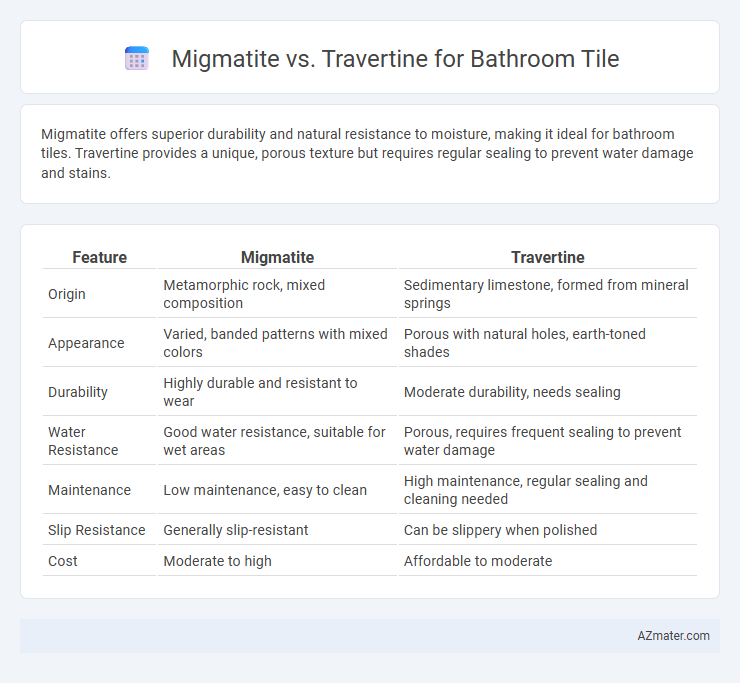Migmatite offers superior durability and natural resistance to moisture, making it ideal for bathroom tiles. Travertine provides a unique, porous texture but requires regular sealing to prevent water damage and stains.
Table of Comparison
| Feature | Migmatite | Travertine |
|---|---|---|
| Origin | Metamorphic rock, mixed composition | Sedimentary limestone, formed from mineral springs |
| Appearance | Varied, banded patterns with mixed colors | Porous with natural holes, earth-toned shades |
| Durability | Highly durable and resistant to wear | Moderate durability, needs sealing |
| Water Resistance | Good water resistance, suitable for wet areas | Porous, requires frequent sealing to prevent water damage |
| Maintenance | Low maintenance, easy to clean | High maintenance, regular sealing and cleaning needed |
| Slip Resistance | Generally slip-resistant | Can be slippery when polished |
| Cost | Moderate to high | Affordable to moderate |
Understanding Migmatite: Composition and Characteristics
Migmatite, a hybrid rock composed of interlayered metamorphic and igneous materials, features a unique blend of quartz, feldspar, and mica that creates its distinctive veined appearance. Its robust structure and natural resistance to wear make it an excellent choice for bathroom tiles, offering both durability and aesthetic appeal. The intricate patterns and high hardness contribute to a slip-resistant surface, enhancing safety in wet environments compared to the more porous and softer travertine.
Travertine Tiles: Formation and Unique Features
Travertine tiles form through the rapid precipitation of calcium carbonate in mineral-rich springs, resulting in a porous and textured surface with natural pits and veins. These unique features provide excellent slip resistance and a warm, earthy aesthetic ideal for bathroom environments. Their natural porosity requires sealing to prevent water absorption and maintain durability in wet conditions.
Aesthetics: Visual Differences Between Migmatite and Travertine
Migmatite features a swirling, banded appearance with contrasting colors formed by the partial melting of metamorphic rocks, offering a unique, dynamic visual texture ideal for modern bathroom designs. Travertine presents a softer, more uniform look characterized by natural pits and veins in earthy tones like beige, cream, and warm browns, creating a classic, timeless aesthetic. Choosing between migmatite and travertine depends on whether a bathroom space aims for bold, natural complexity or elegant, subtle warmth in its tile design.
Durability and Maintenance Comparison
Migmatite offers exceptional durability due to its natural formation under high pressure and heat, making it resistant to cracking and chipping in bathroom environments. Travertine, while aesthetically appealing with its unique porous texture, requires regular sealing and more intensive maintenance to prevent staining and water damage. Both materials provide distinct looks, but Migmatite generally demands less upkeep and offers superior resistance to everyday bathroom wear and moisture exposure.
Water Resistance and Bathroom Suitability
Migmatite offers excellent water resistance due to its dense, metamorphic composition, making it highly suitable for bathroom tiles where moisture exposure is constant. Travertine, a porous sedimentary stone, requires sealing to protect against water absorption and staining, which can compromise its durability in wet environments. For bathrooms, migmatite is generally preferred for long-term water resistance and maintenance ease, while travertine offers a luxurious aesthetic but demands more care to maintain its appearance and function.
Installation Considerations: Migmatite vs Travertine
Migmatite requires professional installation due to its heterogeneous structure and vulnerability to cracking during cutting and drilling, demanding specialized tools and techniques. Travertine tiles are more manageable for DIY installation, benefiting from uniform thickness and easier cutting, though they still need sealing to prevent moisture absorption. Both materials require a level subfloor and proper grout to ensure durability and resistance to bathroom humidity.
Cost Analysis: Budgeting for Each Tile Option
Migmatite tiles typically cost between $8 and $15 per square foot, offering a durable and unique stone option for bathroom flooring. Travertine tiles range from $5 to $10 per square foot, making them a more budget-friendly choice while still providing a natural, elegant appearance. Installation costs for both vary, with travertine often requiring more maintenance, potentially increasing long-term expenses.
Environmental Impact and Sustainability
Migmatite, a natural metamorphic rock, offers durability and minimal environmental impact due to its longevity and minimal processing compared to travertine, which is a sedimentary limestone extracted from quarries that can lead to habitat disruption and higher carbon emissions. Travertine's porosity requires sealing and frequent maintenance, increasing chemical usage and environmental footprint over time, while migmatite demands less upkeep, reducing resource consumption. Choosing migmatite for bathroom tiles supports sustainability goals by leveraging a more resilient and eco-friendly material with lower lifecycle environmental costs.
Design Flexibility and Style Versatility
Migmatite offers unique, swirling patterns with a blend of light and dark minerals, enhancing bathroom tile design flexibility by adding natural, artistic visual interest ideal for modern or rustic styles. Travertine's uniform, porous texture provides style versatility through its warm, earthy tones, fitting seamlessly into classic, Mediterranean, or contemporary bathroom aesthetics. Both materials allow customization with various finishes--polished, honed, or tumbled--enabling tailored looks that suit diverse design preferences and functional requirements.
Choosing the Best Tile for Your Bathroom Remodel
Migmatite offers a unique blend of durability and striking natural patterns, making it ideal for bathroom tiles that require both strength and aesthetic appeal. Travertine, valued for its warm, porous texture and classic elegance, is well-suited for creating a luxurious, spa-like atmosphere but requires proper sealing to resist moisture and stains. When choosing the best tile for your bathroom remodel, consider migmatite for high-traffic durability and visual impact, while travertine suits designs prioritizing warmth and timeless beauty with ongoing maintenance.

Infographic: Migmatite vs Travertine for Bathroom Tile
 azmater.com
azmater.com